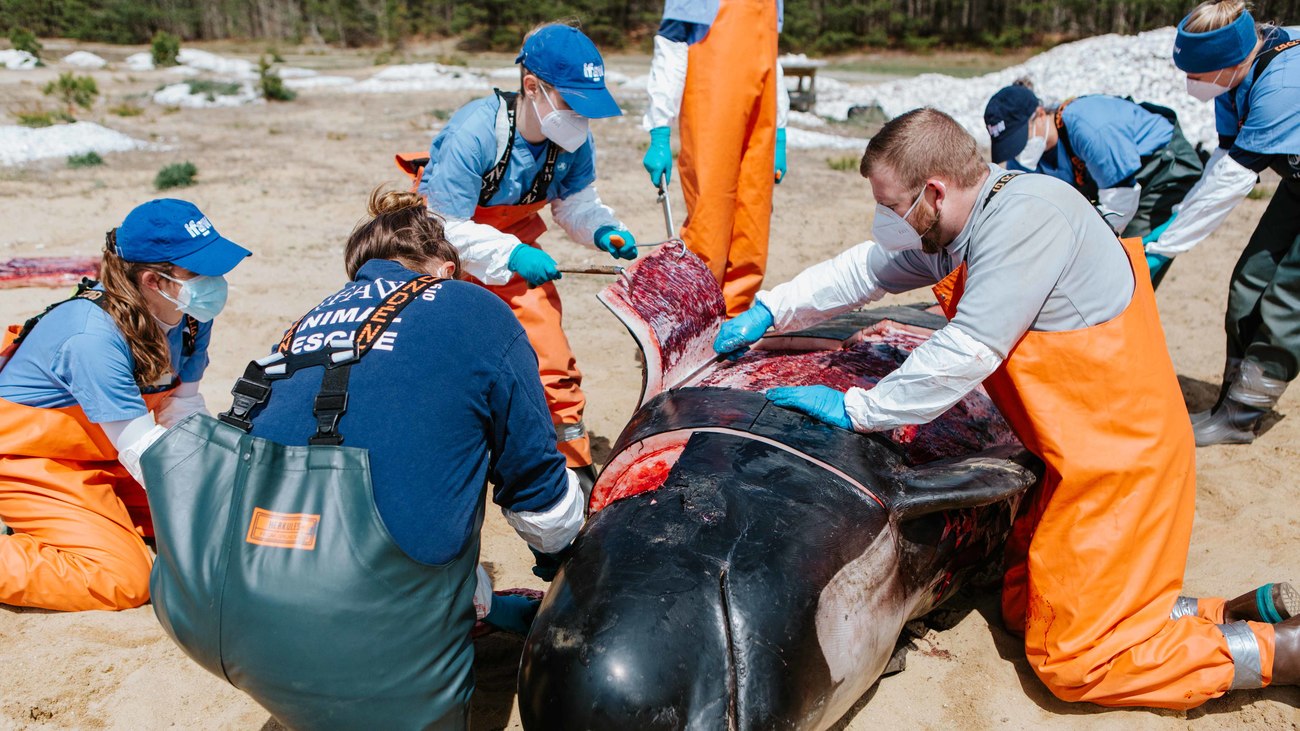Misty Niemeyer
what we can learn from a whale necropsy
what we can learn from a whale necropsy

It’s not every day that a whale strands along the coast of New Bedford, a seaside town nestled between Boston, Providence and Cape Cod. But when a pilot whale was seen circling the shallow cove earlier this month, our internationally-recognized Marine Mammal Rescue & Research (MMRR) team was thankfully headquartered nearby.
Why do whales strand, why did this whale strand, and what does her eventual death tell us about whale strandings around the world?
Responding to a whale in need
Our team received a call to our stranding hotline around 8am that Saturday morning. Pilot whales are a social species living in groups called pods that spend most of their time in deep, offshore waters. The fact that this animal was both alone and in shallow water close to shore was concerning.
With more than 220 trained IFAW volunteers across the region—including those in the New Bedford Police Department’s Animal Control division—we quickly dispatched those close by to monitor the animal and keep the public back a safe distance while rescue teams quickly packed the gear needed for such a large animal and got on the road.
When I arrived on scene, I could see a growing crowd of curious spectators forming to learn more about this animal and our rescue efforts. It’s always devastating to see an animal struggling, but I’m hopeful that our presence aids in educating, and even instilling respect and hope for the species we share our home with.
Eventually, the whale stranded around 4pm that day and our veterinarian, Dr. Sarah Sharp, examined her and found her in poor condition, indicating that euthanasia would be her most humane option. Dr. Sharp had only begun administering initial sedatives when the whale passed away—a further indication of how poor her health was.
Necropsies are an animal autopsy
Our IFAW MMRR team does not stop there, however! We began our work more than 22 years ago, realizing that the geography of Cape Cod, the shallow shores and the presence of a variety of marine mammal species created a unique and frequent hotspot for mass stranding events. Since then, our team has grown to respond to more than 5,870 stranded, entangled or otherwise compromised dolphins, whales, seals and more to-date. Not every animal can or should be saved, and for those animals, we have the obligation and opportunity to learn everything we can about their health and why they stranded. With each post-mortem examination, we learn things that affect the welfare of future stranded individual animals, all while contributing to the conservation of species around the world.
A necropsy, or animal autopsy, enables us to closely examine an animal, both externally and via its internal organs, for information as to why the animal died—or in this case, what led to its stranding. The New Bedford pilot whale necropsy was performed the following day, and findings revealed signs of severe ear infections in both ears that likely contributed to her poor condition and stranding.
What other kinds of things do we learn? This older adult female, long-finned pilot whale weighed in at 2,080 pounds (943kg). A piece of plastic was found in her stomach, which may have contributed to a large stomach ulcer that was also found, but it was not likely the cause of her stranding. Various other, more minor pathologies were also present, and further samples have gone off to a lab for analysis.
In this instance, there was no indication of vessel-induced trauma or that entanglement played a role in her poor condition. But human interaction is always something we watch for.
Local action, global impact
With so many stranding events in our region (no location in the world sees more frequent mass strandings of dolphins, for instance!), we not only have a unique opportunity to rescue and provide cutting-edge veterinary care to these individual animals, but also to drive constant innovation and groundbreaking research that can be shared with collaborators from around the world.
IFAW’s MMRR team is frequently called on to train and advise other response teams, improving the welfare, rescue techniques, and veterinary care provided to stranded marine mammals around the world. This includes more than 16 countries to-date: the UK, New Zealand, Belize, Iceland, Oman, India, Canada, Spain, Madagascar, Trinidad, Russia, Argentina, Peru, Australia, Brazil and South Africa.
In short, the work we do after a stranding or rescue event is sometimes equally as important. We’re deeply engrained in the science, and in what we can learn with every stranding. True to our belief that every individual animal matters in conservation.
All activities conducted under a federal stranding agreement between IFAW and NMFS under the US Marine Mammal Protection Act (MMPA).
Related content
Every problem has a solution, every solution needs support.
The problems we face are urgent, complicated, and resistant to change. Real solutions demand creativity, hard work and involvement from people like you.